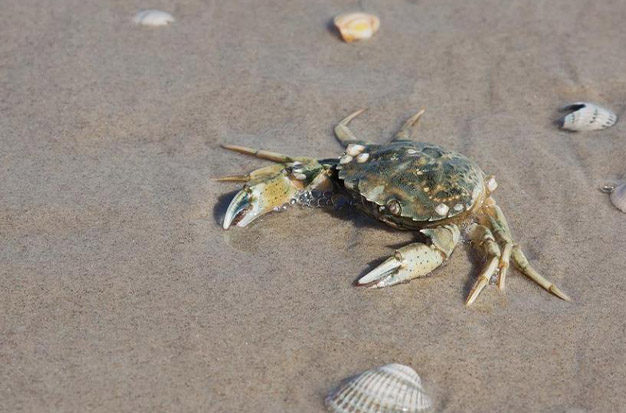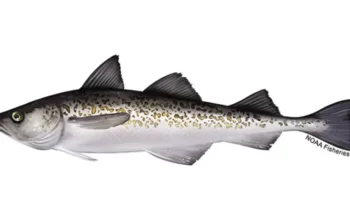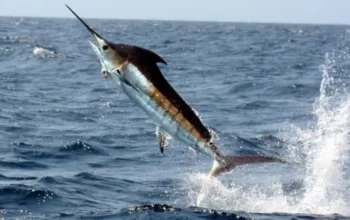You’re in luck if you want to catch crabs on a beach just for fun or if you want to gather some for crab cakes. There are many different ways to catch crabs, from simple ones like looking on the beach or using a hand line to more complicated ones like dropping a trotline or using a crab pot. To get started catching a crab, refer to step 1!
Table of Contents
Where To Catch Crabs?
In both freshwater and saltwater areas of the United States, there are numerous species of crab.
King and snow crabs, which are common in Alaska, Dungeness crabs, which are found on the West Coast, and Atlantic blue crabs, also referred to as Chesapeake blue crabs, are some of the most sought-after saltwater crabs to catch. Consider traveling to places like brackish rivers, bays, and inlets since saltwater crabs prefer shallow, marshy areas. And although you can crab by boat, the great thing about crabbing is that you can have just as much success from land. When making your travel plans, look for areas near docks, piers, and jetties because crab prefer to be close to structures.
In shallow water close to land, anglers can catch freshwater crabs like fiddler and red crabs. These species are frequently found near shorelines with cover, such as beaches with rocks, boulders, or vegetation. A popular habitat type is rocky reefs.
Three Ways To Catch Your Own Crabs
Hand-lining
In Maryland, hand-lining, also known as chicken-necking, is a deeply ingrained custom. What young person in the area hasn’t sat on a dock, a net at the ready, easing a kite string towards the surface? Furthermore, the fact that hand-lining requires no license, almost no equipment investment, and no specialized skills is one of the reasons it is still so widely used today. A crab trap, a net, and some bait are all you need. The standard is a pack of chicken necks, but the head of the fish you caught the other day will also do.
Simply tie your bait to the end of your string, drop it to the bottom from just about any public dock or pier in the Bay or any of its tributaries, and wait. It’s really that easy. A dozen or so lines are typically laid out by crabbers, who then patrol the dock while inspecting each line one by one. When a crab grabs the bait and pulls, the line will stretch out at an angle, letting you know it’s time to slowly pull the bait up until you can see the crab. This will prevent the crab from being startled or scared off. Then you’re in business with a quick sweep of the net.
Hand-Lining Tip: Bring some small fishing weights that you can attach to the line. If the bait floats up, you won’t catch many crabs because you need to get to the bottom.
Snap-trapping
Snap-traps, also known as collapsible traps or jerk-traps, have sides that swing open when the trap is on the ground but close when you pull on the line. Due to three factors, these are very popular: first, they require no expertise to use (if you can pull on a line, you can operate a snap-trap); second, early in the season before the crabs have moved shallow you can use them in areas too deep for running a trot-line; and third, they can be moved around far more easily than a trot line when you’re having trouble locating the crabs.
In order to hold the bait in place in the center of the bottom panel, some snap-traps have a small cage or arms; in other instances, you may need to tie the bait down with string or a zip-tie. You are allowed to set them off from any boat, pier, or bridge that allows fishing and crabbing. In fact, setting snap-traps with anything from a skiff to a yacht is an easy way to catch a lot of crabs when you rent a boat for the day.
As implied by their names, “snap-trap” and “jerk-trap,” respectively, you should apply tension with an abrupt tug when pulling one of these traps in. By doing this, the hinged sides of the trap will swing shut as quickly as possible and the crab won’t be able to escape by scooting. Don’t worry if the snap-trap doesn’t have a top; many don’t, and some prefer open tops because they can be stacked more compactly, making it possible to crab from a kayak or a very small boat. As long as you keep pulling the snap-trap up after drawing the sides closed, crabs almost never escape because they swim sideways and downward when they’re scared.
How do you determine the right time to set the traps? Since there is no way to tell when a crab enters one, most people choose to wait five to ten minutes before taking a look. It’s customary to idly move from one trap to the next checking them essentially nonstop if you set out 12 or more.
Snap-Trap Tip: Stick with chicken necks as bait when using a lot of traps. They are very durable, and if a crab gets into one soon after you drop it, it will have plenty of time to chew on the bait while you check all the other traps. Old fish parts make excellent bait because they are much more quickly ripped apart and consumed. For more details on how to catch crabs using this method, check out How to Go Crabbing with Pull Traps
Trot-lining
Running a trot-line is the most efficient tactic if you’re going for a full bushel basket. However, using one requires expertise, practice, and a sizeable equipment investment (including a boat). Additionally, there is a lot of preparation work and bait required. Every time you use a standard 1200-foot trot-line, you must attach 200 chicken chunks because there is a bait every five to six feet on the line.
You’ll need floats and anchors to place at either end of the line in addition to the line itself. You must also rig your boat with a “stick,” which is a U-shaped arm that sticks out to the side. Once the line is ready, you pull up the float at one end, snag the line underneath it, drop it into the U on the stick, and slowly advance. The crabs won’t even notice the trot line being pulled up from the bottom if you move the boat slowly and steadily. One person steers the boat, and another has a net in hand posted forward of the stick, ready to catch crabs as they surface from the depths.
Actually, booking a crabbing charter is the best option if you haven’t run a trot-line before. You’ll likely go home with as many crabs as you can stand to eat because these are quite common on the Bay and you’ll not only get to watch how the pros do it. By using a charter, you can enjoy a relaxing day on the water with a lot less effort than if you did it all yourself, avoid having to bait and unbait the fish, and travel on a large, comfortable boat that can accommodate the whole family.
Trot-Line Tip: To determine the best depth, lay the line over an underwater point. Then, adjust your line so that more of it is in the desirable depth range. We must emphasize this once more: running a trot line can be a bit complex and the best way to learn how to it’s done is to take a charter, before trying it on your own. For more crabbing advice, be sure to read 10 Trot-Lining Tips
We can’t advise you on when to give up some of your cherished fishing time to go crabbing. Only you, along with those two voices screaming at each other inside your head, can decide that; it’s a personal choice.

Step – By – Step Guide
Step 1: Warning
-Crabs can pinch you because they have claws. If this occurs, don’t freak out. Your other hand should be used to pull the crab away from you until the claw separates from the crab. In later steps, the correct way to hold a crab is demonstrated.
-Size restrictions for crabs vary annually. To steer clear of any potential legal issues, check online or at your neighborhood marina. For more information, go to http://www.scottsbt.com/fishids/regsrecs/regsNJ.htm.
-The East Coast is also home to other crabs like spider crabs and green crabs. Because they cannot be eaten, these crabs should be released after capture.
-If the crab is carrying an egg sac, the law requires that it be released.
Step 2: Caution!
Do not eat a crab that has expired before it has been cleaned. After the crab expires, a poison spreads throughout its body, ruining the meat.
Step 3: Equipment
-Cooler
-Fold up chair
-Bag of Ice (sold at local convenience stores)
-Crab trap
-Bait
-Junk Knife (for bait)
-Snacks for yourself
-Thick Gloves(makes holding crabs easier)
-Net(if using a hand line)
Step 4: Areas For Crabbing
Saltwater is the habitat of crabs. Brackish water, also referred to as tidal water, is included in this. These places include the ocean, bays, inlets, and saltwater marshes. Crabs also favor being close to submerged structures like pilings, bridges, and sunken shipwrecks, which are typically from docks.
Step 5: Hold A Crab
1. To stop the crab from moving, place your foot—preferably in a shoe—on it. No flip flops or sandals.
2. Grab the crab’s flipper or last leg at its back with one hand.
3. Lift the crab up by removing your foot.
4. It won’t be able to pinch you.
Step 6: Types Of Bait
Dead Fish-It doesn’t matter what kind of fish you eat as long as it’s a manageable size, which is typically between 6 inches and 1 foot. Bunker, snapper blues, and sea robins are a few popular fish varieties. If the fish is cut into 2 by 6 inch pieces, it can be used more effectively. Make sure the fish has cuts so the smell can easily permeate the water.
Hot Dogs-Because they are so soft and convenient for crabs to tear apart and consume, hot dogs are not frequently used. If you’re on a tight budget, hot dogs might be the best option because they are significantly less expensive than traditional bait.
Chicken-I prefer chicken legs. A reliable bait is chicken, which is less expensive than fish. This indicates that the crabs won’t be able to easily disassemble it and take it away.
Meat-The three meats mentioned above are the cheapest to purchase and the simplest to use, though any meat can be used.
Step 7: How To Use Traps
Weighted Hand lines/drop lines– This rope has a heavy-duty hook attached to the end of it. The weight prevents the lure from rising. To prevent the crab from pulling the entire line into the water, tie the end of the string without the hook to something solid. To stop crabs from consuming the bait, the hook is securely attached with bait. Once the bait is attached to the hook, it is typically thrown 8 to 12 feet out into the water from a bank. In shallow water, it can also be thrown over the side of a boat as long as the meat makes it to the bottom. Wait five to ten minutes or until you see the line starting to move before beginning to slowly draw it in. If a crab is present, check it out once the meat is visible. If not, fish that meat out of the water and return it to it. Pull the line a little closer if there is a crab present, but make sure to keep the crab 1 to 2 feet below the surface. Grab a net, then sluggish lower it behind the crab in the water. Crabs move quickly, so scoop the crab out of the water quickly. Once done, you will have successfully caught a crab.
Box Crab Traps-Mesh that resembles wire is used to make this trap. It has a top, a bottom, four open sides, and flaps that open and close the sides. All of the strings are joined at a ring that is situated above the trap and are attached to the flaps. The sides of the trap are sealed off by the flaps when a longer string that is attached to the ring is pulled.
When crab fishing, a piece of meat is put in the middle of the trap and fastened down. The sides of the trap will close when the crab eats, trapping the crap inside and preventing any chance of escape.
Pyramid Crab Traps-A wire-like mesh is used to construct this trap. It is constructed out of a square and four triangles. Each side of the square is connected to a triangle. The triangles’ ends have strings attached to them. A ring situated above the trap is where the strings converge. The flaps on the sides of the trap are sealed off by a longer string that is fastened to the ring and pulled when the string is pulled.
When crab fishing, a piece of meat is put in the middle of the trap and fastened down. The sides of the trap will close when the crab eats, trapping the crap inside and preventing any chance of escape.
Ring Crab Traps-Wire mesh or string are both used to construct this trap. It is circular in shape. Although it appears flat when lying on the ground, when picked up, the bottom drops down, trapping the crab inside. Typically, a weight of some kind and the bait are placed in the trap’s center.
Commercial Crab Traps-Except if you are using them from a dock that is privately owned, you need a license to use these traps. Usually 2 to 3 feet wide, these traps are substantial. They can hold a lot of bait and are frequently left in the water. They have the capacity to house lots of crabs.




